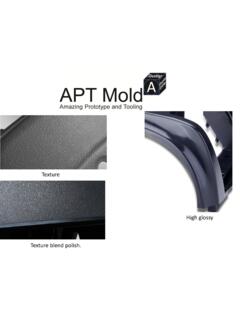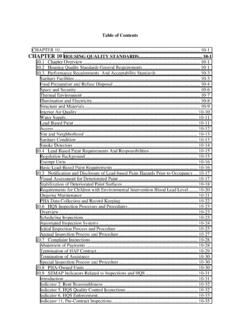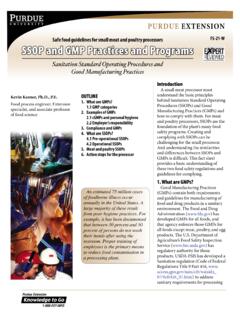Transcription of Cosmetic Inspection Standard - APT Mold
1 CosmeticInspectionStandardCosmetic Inspection Standard Identification and Cosmetic specification viewing condition(Table 1)12 Matching, Surface finish and texture PURPOSE matching, Reference Standard for Parts(Table 2)16 23To establish and communicate a standardized method of inspecting parts/product for Cosmetic issues in a uniform and subjective way. SCOPE This procedure shall be used to inspect all the parts/product, unless given different specifications by the customer. Defect Definitions Burn marks: Brown to black, irregular and locally variable discoloration of the molded part, also see gas marks: Dark discolored streaks caused by incomplete venting of gases generated during the molding shot(non fill):Missing plastic due to incomplete filling of the mold cavity. Parts are not completely formed, generally at the ends of flow paths or at thin sections, Can usually bid tifi dbthhidddfbe identified by smooth, shiny and rounded mark:Surface depression caused by non uniform material solidification and shrinkagemostoftennotedatinterfacebetwee ndifferingwallthicknessesshrinkage, most often noted at interface between differing wall , localized hollows in the surface, generally found opposite ribs, at thicker sections, cores, weld lines, constrictions, hot runner nozzles and the end of flow : Excess plastic at parting line or mating surface of the mold, Normally very thin and flat protrusion of plastic along an edge of a part.
2 Can also appear as a very thin string or threadofplasticawayfromtheedgeofapart(st ringflash)OftenfoundatventsKnockthread of plastic away from the edge of a part(string flash). Often found at vents, Knock outs and other shut off mark: Surface imperfection due to abrasion that removes small amounts of material, Depth is not measurable, Differs from scratch in mold which leaves a consistent mark,scratches running in the de molding direction, also visible as matt streaks on high gloss mark: Generally serpentine strand of the melt first injected into the mold,found near the sprue or at constricted sections, and visible on the part lines:Witness line where 2 or more fronts of molten plastic converge, also called knit lines or flow lines, the weld around the holes, the line between the injection thickness varying mark: The marks can be viewed in the thickness varying and transition area, it generally happen on the recess area, thick wall thin wall thick.
3 Molded parts do not match specification drawing, suffer warpage at corners or do not fit , Bubbles: Round or elongated bubbles generally only visible in transparent and translucent parts, May appear as a bulge or protrusion in an opaque streaks: Elongated silver : Glossy or shiny areas on textured surface. Usually caused by a dirty or worn mold. Can also be caused by lack of sufficient pressure to properly replicate texture in the : Off colored streaking. Usually appears silver like. Splay is caused by moisture in the material or thermal degradation of the resin processing. A Similar look can be caused by cold material skipping across the surface during a fast fill. This is commonly called Jetting .Gouge: Surface imperfection due to abrasion that removes small amounts of material, Depth is : Any type of machine lubrication on the surface of a :CloudinessonanotherwisetransparentpartH aze: Cloudiness on an otherwise transparent Slug: First material to enter mold during injection.
4 Solid or semi solid, this material leaves a distinctborderwithadjacentmeltedmaterial similarinappearancetoweldlinesdistinct border with adjacent melted material similar in appearance to weld : Cloudiness on an otherwise transparent : Small discolored points of matter embedded in the surface. Typically black, caused by material contamination or material idi t tidbjtihiittthlPin Push: Protrusion or distortion caused by an ejector pin pushing into part more than protrusion is most evident on the surface opposite the ejector :Rippledormottledappearanceviewableascon centriclinesCausedbyunderOrange Peel: Rippled or mottled appearance view able as concentric lines. Caused by under pressurizing. Orange peel is often the first sign of possible sink or :LikegougesbutofshortlengthCausebyimpact ratherthanabrasionNicks: Like gouges but of short length.
5 Cause by impact rather than : Colored streaks caused by incomplete mixing of 2 different colored plastics. Also to as Problems (Not a true Cosmetic defect. More functional than Cosmetic )Errors related to the installation of inserts into plastic parts. Inserts can be set too high or too ppglow in a socket or boss. They can also be damaged or misaligned and may even be : Stress induced splitting or fissures causing separation of : Multiple tiny cracks due to stress exerted on the : Separation(peeling) of layers of : Any change from the original color Standard . Unintended, Inconsistent : Part distortion caused from plastic catching in the mold when the part is : Crater like imperfections on the surface of the Marks: Clusters of scratches from plastic dragging against mold details when a part is ejected from a : Large areas of discoloration from foreign matter or foreign material embedded in the surface of a : Discoloration or change in gloss.
6 Generally occurring at gate locations or abrupt changes in wall : General damage. For example bent and/or broken tabs or (Paint or decoration): Evidence of one color overlapping or altering another color(painting). Spreading of pigment beyond the intended boundaries(silk screen, printing).Fill ins(print or silk screen): An excessive use of ink that alters the form of screened or printed feature. Placement of ink where no ink should ( itilk)WifdilijtibttFlow Marks(paint or silk screen): Waviness of edge or excessive linear junction between two surfaces of ink or (paint):Anyunintendedforeignsubstanceint hecoatingoronthesurfaceLint(paint): Any unintended foreign substance in the coating or on the adhesion(Painted or decorated): Lack of adequate sticking of paint, print or any coating to theplasticsurfacethe plastic (painting or printing): Dripping or sagging of paint or ink.
7 Movement of ink beyond intendedsurfacesUsuallycausedbytoomuchor toothickpaintorinkintended surfaces. Usually caused by too much or too thick paint or (Paint or Ink): Similar to bleeding. Excess ink or paint in areas that should be free of ink or paint. Smearing is due to rubbing of surface before adequately At time of RFQ, the Sales Engineer and customer will review the product and determine surfaceclassification( ). Work Instructionssurface classification (see sections for more information on part classification). After these surfaces have been reviewed and agreed upon with the customer, the internal controlled prints will note the corresponding surface classification. During the fabrication of product, per Work Instruction Form, auditor will verify that product conforms to this specification. If product does not conform to this specification, defect will be documented on the Inspection History Form and Quality will determine part Surface Identification and Cosmetic specification General For components or assemblies , Cosmetic Inspection shall use the Time and DistanceInspectionproceduredescribedbelo w(Table1)andshallrelyonthejudgementofDis tance Inspection procedure described below (Table 1) and shall rely on the judgementof trained auditor and suppliers.
8 If flaws are noticeable within this specification, refer to the Cosmetic Reference Standard (Table 2). This added specification will assist our trained auditor in ,productmaking an accept/ reject decision. If the product does not conform to this specification, product will be placed on hold. Surface finish: Grade 1 Highly polished( B1 or lower).Clear contact (Primarily applies to medical parts).Grade 2 Low grade polish, non textured: ( B2 or higher). 3 Painted 4 Ink stamped, printed, silk decorative Cosmetic Class Codes The Cosmetic class codes used in this Standard use letters from A through D . Class A isreservedforthetoporfrontmostoftenviewe dsurfaceClass A is reserved for the top or front, most often viewed B is generally the front edge and sides of a part. Not viewed as often as an A surface but easily seen by C isgenerallyspecifiedformostoftenthebacka ndbottomsurfaceClass C is generally specified for most often, the back and bottom D is generally internal surface.
9 Normally D surfaces are not inspected for Cosmetic attributes. Where, necessary, D surface Inspection will be specified as an Application External applications include front panels, covers, and frames that are readily visible in the final assembly. Internal components are generally seen only by assembly and technical personnel and are less important cosmetically. Some components, such as the inside of a door, may have both an internal and external application. This will be our default code unless directed otherwise by the customer. 10 Side,frontedgeSide, front edge Will be defined as Class BFront, top will beDefinedasClassADefined as Class AInternal Will be defined as Class DThe back and bottom will be defined as Viewing Conditions Parts and products shall be inspected under the following conditions. Standard viewing conditionA.
10 Lighting intensityAll quality decisions of Cosmetic acceptability will be made under normal lighting conditions(80 120 foot candles) in white fluorescent Viewing AngleAll viewing will take place with direct overhead lighting. Viewing angle is dependent onsurfaceclassificationsurface every case, parts will be held such that the light is NOT REFLECTED directly to the surface Hold part 30 from the horizontal is in direct line with your part 30 to the right and to theleft about the vertical degree18 1224 B surface Hold part 90 from the horizontal is in direct line with your NOT Rotate the surface Hold part 90 from the horizontal degreePart is NOT in direct line with your is held 45 below the plane of your DO NOT rotate the DistanceA surface 18 inchesB surface 24 inchesCf30ihC surface 30 inchesInspection interval(time)Surface areaA SurfacesNon A surfaces<=4 in2 (2 x 2 )2 16 in2 (4 x 4 )4 64 in2 (8 x 8 )6 144 in2 (12 x 12 ) 8 sec.





